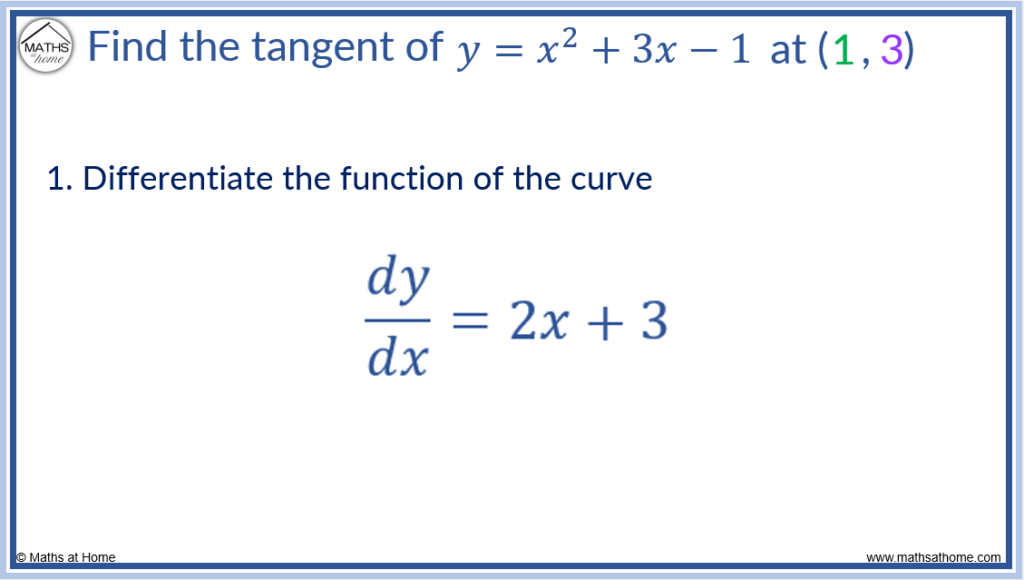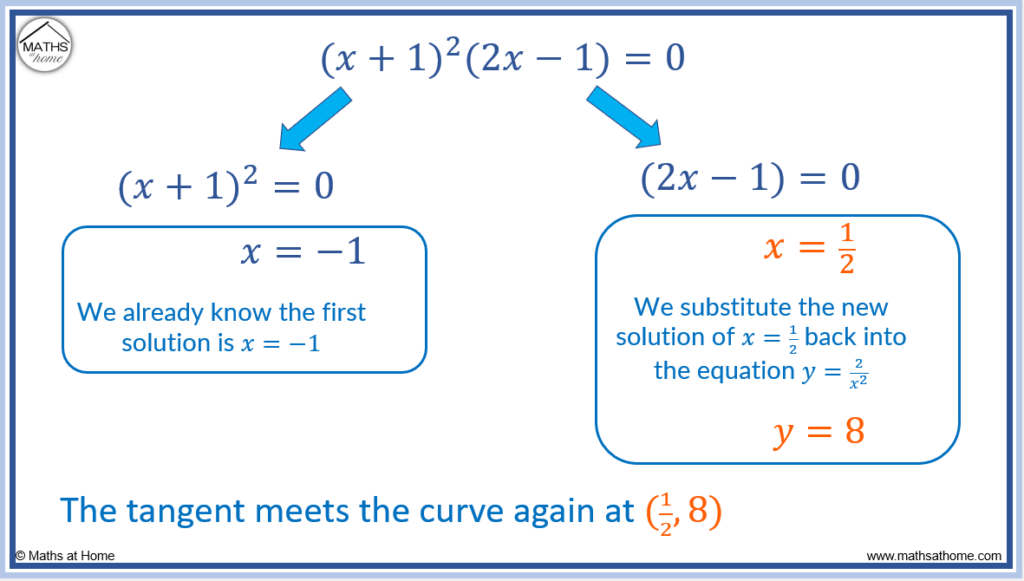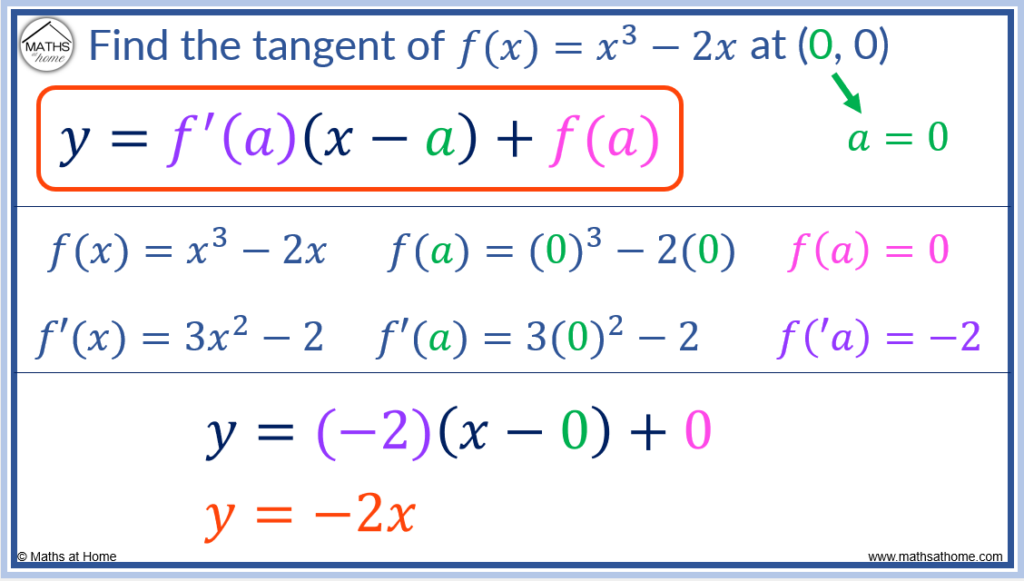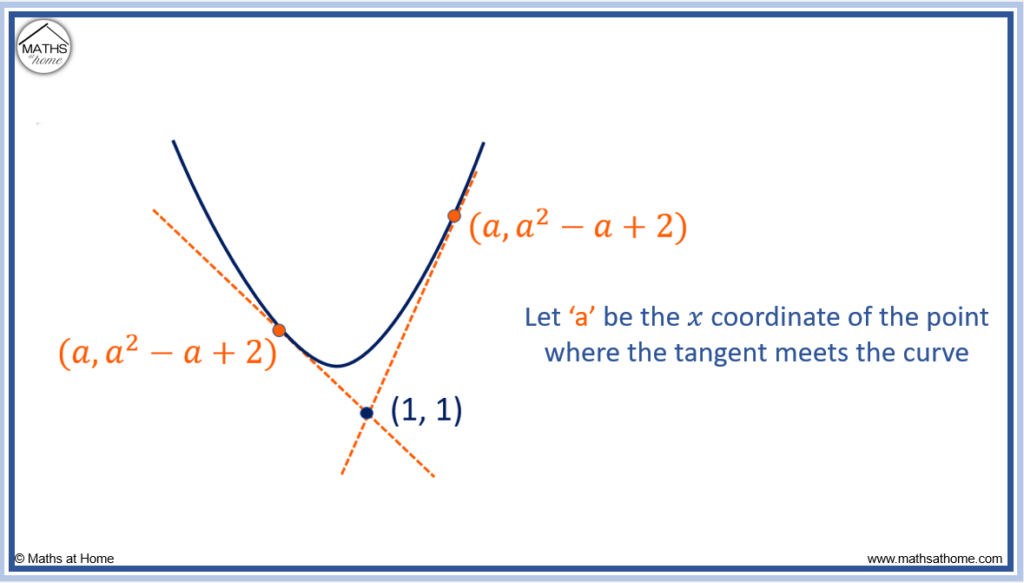How to Find the Equation of a Tangent: Video Lesson
What is a Tangent to a Curve?
A tangent line to a curve is a straight line that just touches the curve at one point. The tangent line has the same gradient as the curve does at this point.

The tangent to the curve above is shown in red.
The tangent to a curve just touches the curve at a given point. It does not pass through the curve at this point, although it can intersect the curve at another location.
A line that passes through two points on a curve is called a secant line. The secant line is shown in green above. This is not a tangent line.
How to Find the Equation of a Tangent using Differentiation
- Differentiate the function of the curve.
- Substitute the x-coordinate of the given point into this derivative to find the gradient, ‘m’.
- Substitute the given coordinates (x,y) along with ‘m’ into ‘y=mx+c’ and then solve to find ‘c’.
- Substitute these values of ‘m’ and ‘c’ into ‘y=mx+c’.
Example 1: Equation of the Tangent to a Parabola
For example, find the equation of the tangent to the curve at the point (1, 3).
Step 1. Differentiate the function of the curve
If , then

Step 2. Substitute the x-coordinate of the given point into this derivative to find the gradient, ‘m’
The gradient anywhere on the curve is found by the gradient function, .
The tangent is at the point (1, 3).
Here, x=1.
Substituting x=1 into the gradient function , the gradient at this point is found.
and so, m=5.

Step 3. Substitute the given coordinates (x,y) along with ‘m’ into ‘y=mx+c’ and then solve to find ‘c’
Since the tangent is at the point (1, 3), this is where x = 1 and y = 3.
The value of m at this point was previously found to be m = 5.
The tangent is a straight line and so, is represented with the straight line equation .
Substituting the values of x = 1, y = 3 and m = 5 into this equation, it becomes .
Solving this equation for c, it is found that c = -2.

Step 4. Substitute these values of ‘m’ and ‘c’ into y=mx+c
It has been found that m = 5 and c = -2.
Replacing these values in , the equation of the tangent is
.

How to Find Where the Tangent Meets the Curve Again
To find where a tangent meets the curve again, first find the equation of the tangent. Then use simultaneous equations to solve both the equation of the tangent and the equation of the curve. Each pair of x and y solutions corresponds to a coordinate (x, y) where the tangent intersects the curve.
For example, find the tangent to at (-1, 2) and find the coordinates where the tangent intersects the curve again.
Firstly, the equation of the tangent is found.
Since , the derivative
.
Substituting into this derivative, it is found that
.
Substituting ,
and
into
,
and so,
.
Therefore since and
, the equation of the tangent is
.

To find where a tangent to a curve meets the curve again, solve the equation of the tangent and the equation of the curve simultaneously.
Simultaneous equations are used to find the coordinates of intersection of two lines.
The equations and
can be solved by setting the equations equal to each other to get
.
Multiplying each term by , the equation becomes
.
We subtract 2 from both sides to set the equation equal to zero: .
Dividing each term by 2, the equation becomes: .
We already know that one solution is found at and so one factor must be
.
Dividing by
using polynomial long division, the result is
, which factorises to
.
Therefore can be written as
.


Therefore either (which results in the original solution of
, or
, which gives us a new solution of
.
When , the y coordinate can be found by substituting this back into
to get
.
Therefore the tangent intersects the curve again at .
Formula for the Equation of a Tangent
The equation of the tangent to y=f(x) at the point x=a is given by the formula: y=f'(a)(x-a)+f(a).The formula for the equation of tangent is derived from .
The gradient of the tangent when is equal to the derivative at the point
, which is given by
.
and
can be taken as any
and
points on the tangent line.
is equal to
and
is equal to
.
The gradient equation becomes which can be rearranged to give
.

The equation of a tangent to at the point
is found using the formula:
.
For example, the find the equation of the tangent of at (0, 0).
The x-coordinate of the point (0, 0) is 0 and so, a = 0.
Differentiating the function, .
is found by substituting x = 0 into
.
Therefore, and so
.
is found by substituting x = 0 into
.
Therefore and so
.

To find the equation of the tangent, substitute ,
and
into
.
This becomes which simplifies to
.
Equation of a Tangent to a Circle
To find the equation of a tangent to a circle:- Find the gradient from the centre of the circle to the tangent point.
- Calculate the negative reciprocal of this gradient to find ‘m’.
- Substitute the x and y coordinate values along with ‘m’ into ‘y=mx+c’ and solve for c.
- Put the values of ‘m’ and ‘c’ back into ‘y=mx+c’.
For example, find the tangent to the circle at the point (0, 5).
Step 1. Find the gradient from the centre of the circle to the tangent point
The centre of the circle is at (1, 3). The tangent point is at (0, 5).
The gradient is found using .
Evaluating this for the two points, which equals -2. The gradient between the centre and the point given is -2.

Step 2. Calculate the negative reciprocal of this gradient to find ‘m’
The gradient of the tangent to a circle is perpendicular to the gradient from the centre to the same point.
The gradient of a line is found by the negative reciprocal of the gradient of the line perpendicular to it.
To calculate the negative reciprocal of a number, calculate -1 divided by that number.

and so the gradient of the tangent to the circle at this point is
.
The value of ‘m’ for the tangent line to the circle is .
Step 3. Substitute the x and y coordinate values along with ‘m’ into ‘y=mx+c’ and solve for c
The tangent is at the point (0, 5) so we substitute ,
and m =
into the straight line equation
.
This results in and so,
.

Step 4. Put the values of ‘m’ and ‘c’ back into ‘y=mx+c’
It was found that m = and c = 5. Therefore the equation of the tangent to the circle is
Equation of a Tangent to a Square Root Function
The tangent of a square root function can be found by differentiating it and substituting in the x-coordinate to find the gradient. This can be done by writing the function inside the square root as raised to the power of one half. This can then be differentiated using the chain rule.
For example, find the equation of a tangent to the function at the point (6, 2).
We can use the formula for the equation of a tangent: .
Step 1. Differentiate the function
and this can be written as
.
This can be differentiated using the chain rule to get .
Step 2. Find f'(a) and f(a)
‘a’ is the x-coordinate of the point at which the tangent meets the curve. In this example, .
is found by substituting the value of ‘a’ into the
equation.
and so,
.
is found by substituting the value of ‘a’ into the
equation.
and so,
.
Step 3. Substitute the values of f(a), f'(a) and a into the tangent formula
and so, the equation of the tangent becomes
.
This simplifies to .
Multiplying each term by 4, this can also be written as or rearranged as
.
Equation of a Tangent to y=sin(x)
Find the equation of the tangent to at the point
.
Step 1. Differentiate the function
and
.
Step 2. Find f'(a) and f(a)
‘a’ is the x-coordinate of the point at which the tangent meets the curve. In this example, .
is found by substituting
into
.
and so,
.
is found by substituting
into
.
and so,
.
Step 3. Substitute the values of f(a), f'(a) and a into the tangent formula
and so, the equation of the tangent becomes
.
This expands to give .
Multiplying each term by 8, this becomes: .
Factorising the , this becomes
.
Dividing by 8 both sides, .
Equation of a Tangent with Implicit Differentiation
To find the equation of a tangent using implicit differentiation:- Differentiate the function implicitly.
- Evaluate the derivative using the x and y coordinate values to find ‘m’.
- Substitute the x and y coordinates along with this value of m into (y-y1)=m(x-x1).
For example, find the equation of the tangent to at the point (3, 2).
Step 1. Differentiate the function implicitly
When differentiating implicitly, differentiate each term like usual but remember to include a
after each y term.
differentiates implicitly to
.
Step 2. Evaluate the derivative using the x and y coordinate values to find ‘m’
At the point (3, 2), and
.
Substituting these into , we get
.
Therefore, rearranging for , we get
.
This is the value of m in our straight line equation.
Step 3. Substitute the x and y coordinates along with this value of m into (y-y1)=m(x-x1)
The equation of a straight line can be given as .
,
and
.
Therefore the equation becomes .
This can be expanded to get .
Adding 2 to both sides and simplifying, . This can be written as
.
How to Find the Equation of a Tangent from an External Point
To find the tangent to a curve from an external point, first find the point ‘a’ on the curve where the tangent is. To do this, differentiate the function and set this equal to the change in y over the change in x from the external point to point ‘a’ on the curve. Solve this for ‘a’. Once the location of ‘a’ has been found, find the equation of the tangent in the usual manner.For example, find the equation of the tangents to the curve passing through the point (1, 1).
There are two possible tangents to the curve from this point.
The locations at which the tangent meets the curve will be given the x coordinate of and the y coordinate of
.

Step 1. Differentiate the function
If , then
.
Step 2. Set the derivative at point a equal to the gradient between the external point and the curve
At the point where the tangent meets the curve, and so,
.
The gradient between two points is .
will be taken as the point on the curve
.
will be taken as the external point
.
Therefore becomes
. This simplifies to
.
The value of for the tangent must be equal to this gradient.
Therefore .
Step 3. Solve this equation to find the location of the tangent at ‘a’
Multiplying by a-1, the equation above becomes .
Expanding brackets: .
Since this is a quadratic, we rearrange to make the right hand side of the equation equal to zero: .
Factorising: and so,
or
.
Therefore, the tangent meets the curve at or
.
Substitute these values back into to get (0, 2) and (2, 4) respectively.
Step 4. Work out the tangent equation for each point
Considering the tangent at the first point, (0, 2).
We know that and so,
. Therefore m = -1.
,
and
.
Therefore becomes
and
.
The equation of the first tangent is .
Considering the tangent at the second point, (2, 4).
and so,
and
.
,
and
.
Therefore becomes
and therefore
.
The equation of the second tangent is .
